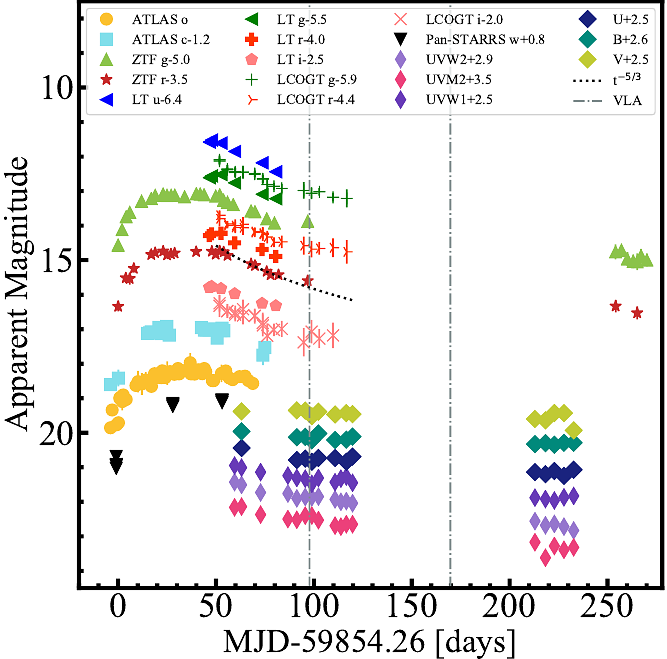The case of AT2022wtn: a Tidal Disruption Event in an interacting galaxy

The case of AT2022wtn: a Tidal Disruption Event in an interacting galaxy
F. Onori, M. Nicholl, P. Ramsden, S. McGee, R. Roy, W. Li, I. Arcavi, J. P. Anderson, E. Brocato, M. Bronikowski, S. B. Cenko, K. Chambers, T. W. Chen, P. Clark, E. Concepcion, J. Farah, D. Flammini, S. González-Gaitán, M. Gromadzki, C. P. Gutiérrez, E. Hammerstein, K. R. Hinds, C. Inserra, E. Kankare, A. Kumar, L. Makrygianni, S. Mattila, K. K. Matilainen, T. E. Müller-Bravo, T. Petrushevska, G. Pignata, S. Piranomonte, T. M. Reynolds, R. Stein, Y. Wang, T. Wevers, Y. Yao, D. R. Young
AbstractWe present the results from our multi-wavelength monitoring campaign of the transient AT2022wtn, discovered by the Zwicky Transient Facility in the nucleus of SDSSJ232323.79+104107.7, the less massive galaxy in an active merging pair with a mass ratio of ~10:1. AT2022wtn shows spectroscopic and photometric properties consistent with a X-ray faint N-strong TDE-H+He with a number of peculiarities. Specifically, a 30-days long plateau at maximum luminosity, a corresponding dip in temperature and the development of a double-horned N III+ He II line profile. Strong and time-evolving velocity offsets in the TDE broad emission lines and the detection of a transient radio emission, indicate the presence of outflows. Overall, the observed properties are consistent with the full disruption of a low-mass star by a ~10$^{6}$ M$_{\odot}$ SMBH followed by an efficient disk formation and the launch of a quasi-spherical reprocessing envelope of fast expanding outflowing material. The observed differences between the He II and the Hydrogen and N III lines can be explained either with a spatial separation of the lines emitting region or with a late-time reveal of shocks from the returning debris streams, as the photosphere recedes. Finally, we present an extensive analysis of the hosting environment and discuss the implications for the discovery of two TDEs in interacting galaxy pairs, finding indication for an over-representation of TDEs in these systems. The AT2022wtn host galaxy properties suggest that it is in the early stages of the merger, therefore we may be witnessing the initial enhanced rate of TDEs in interacting galaxies before the post-starburst phase.